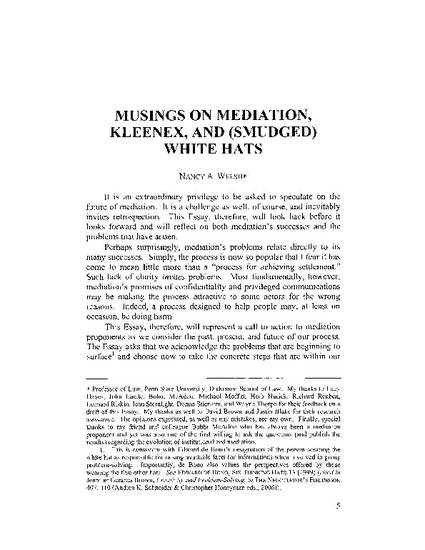
This Essay speculates on the global future of mediation. It anticipates that mediation’s popularity will continue to grow both in the U.S. and abroad particularly as courts continue to encourage and institutionalize the process. Meanwhile, the Essay acknowledges the existence and continuing development of a relatively small cadre of elite lawyers and retired judges who serve as private mediators in large, complex matters.
The Essay also raises concerns, though, regarding the current lack of clarity in the goals and procedural characteristics that define mediation. The Essay asserts that such lack of clarity invites abuse of the mediation privilege and exclusionary rules that apply to mediation communications. The Essay specifically examines Cassel v. Superior Court of Los Angeles County, decided by the California Supreme Court in early 2011, in which the court held that evidence of lawyers’ communications with their client occurring immediately before and during a mediation session was undiscoverable and inadmissible under California’s relevant statutes. As a result, such evidence was unavailable to a client in his action against his lawyers for alleged legal malpractice, breach of fiduciary duty, fraud and breach of contract. While mediation proponents crafted the mediation privilege and related exclusionary rules with the best of intentions -- i.e., to help people take advantage of mediation's potential to enhance communications and develop customized resolutions -- Cassel illustrates the potential for unintended, harmful consequences.
The Essay urges that even though mediation proponents should be proud that their process has become as popular as breakthrough products like “Kleenex” (or perhaps more currently, the "iPad"), such proponents now need to work to define and protect the goals of mediation. The California Legislature has not responded to Cassel with statutory change. Individual mediators, however, can begin to include in their agreements to mediate that, despite any statutory provisions or rules to the contrary, the parties and mediator agree that they will not assert the mediation privilege or exclusionary rules to prohibit the discovery or admission of mediation communications in disciplinary proceedings or malpractice actions against lawyers -- or mediators. Such a provision would be consistent with the Uniform Mediation Act. Such a provision also would make it more likely that mediators will be able to focus on achieving the goals of party self-determination, improved communication and negotiation, and voluntary and customized resolution.
Available at: http://works.bepress.com/nancy-welsh/41/
